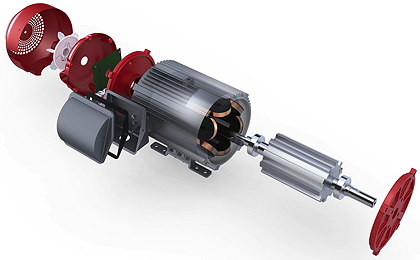- Home » News » World News
Switched reluctance motor aims to disrupt the market

A Californian company has developed a new form of high-efficiency switched reluctance motor which, it claims, will dramatically improve the performance of HVAC, refrigeration, pumping and other applications. The Sunnyvale-based Software Motor Company (SMC) says that its motors will cut energy use by 20–50% compared to Nema Premium motors in the 1-5hp (0.75–3.7kW) range, and will typically pay for themselves within 6–36 months.
SMC, founded in 2013, is using a modified switched reluctance (SR) technology that it acquired from a group of academics at the Illinois Institute of Technology (IIT). Although existing SR motor designs are well-proven in harsh environments where high reliability is essential – such as mines and nuclear reactors – historically they have not been particularly efficient. SMC says that it has invented a combination of hardware improvements and novel control techniques that together deliver “unprecedented” reliability and efficiency.
The company’s executive chairman, Ryan Morris, says that SMC “aims to disrupt an industry that has seen little innovation over the last 40 years”.
Morris contends that SMC is offering the only programmable motor with a matching smart drive. “It is fully programmable unlike anything else on the market,” he says. “We have made developments and improvements in the hardware and software – which is our secret sauce.”
Traditionally, SR motors have had more stator than rotor poles, due to the difficulty of controlling higher rotor pole designs. The SMC motor reverses this, having six stator and ten rotor poles. According to Morris, “this is one of the mechanical advantages that sets SMC motors apart, and allows such high efficiency and power density”. The motors have higher power densities and are claimed to operate more smoothly than conventional designs, with lower torque ripple.
The SMC hardware also has fewer parts than a traditional motor and no rotor current, which means that no energy is wasted in the rotor. It does not need any magnets or expensive materials, and no windings around the rotor. “Fewer parts reduces the risk of parts and motors malfunctioning,” says Morris.
There are improvements on the control side as well. “Our intelligent software enables a leaner mechanical design that provides inherently better efficiency, controllability and reliability,” Morris explains. Learning algorithms are used to optimise performance in real time. The motors can be controlled from PCs or wirelessly from mobile phones. Users can perform analytics, and reprogram or adjust operating parameters from any connected device. SMC plans to offer cloud-based services such as monitoring, data management, and predictive maintenance.
High efficiencies are maintained at all operating speeds and SMC’s control technology – which it calls Smart Motor Drive – ensures that the motor always runs at the optimum speed.
The technology is currently undergoing field trials “with multiple brand-name customers”, and a Californian utility.

“What we have found most interesting is that the field data shows significantly higher savings than the lab testing, which is not normally the case,” Morris reports. “The vast majority of installed motors are oversized for their application as a precautionary measure to deal with load uncertainty. As a result, they are actually operating at a lower efficiency than ideal lab conditions. Since the SMC motor has the same high efficiency at all speeds, this issue is inherently solved.”
Results from the field trials and a series of laboratory tests are due to be published in the coming months.
The Software Motor Company has already attracted more than $16m in funding. In the past few months, the company has more than doubled its workforce, to around 35.
The motors are being produced for SMC by contract manufacturers in China. The current supply chain could produce up to 1,000 motors per day. Morris says that it would be easy to scale up production quickly to meet demand.
At present, the motors are being made in Nema frame versions, but SMC is planning to introduce IEC frame machines for Europe and other markets “by the summer”. Initial ratings are up to 5hp (3.7kW), but 20hp (14.9kW) models are due to go into production soon, and these will be followed by 100hp (75kW) versions later this year.
To achieve a rapid speed-to-market, SMC is initially targeting small, “nimble” OEMs and the retrofit market. It is working with, and training, contractors to perform retrofits. As well building services applications, SMC sees the motors being used in other areas – such as manufacturing and materials-handling – that need high torque at low speeds, wide speed and load ranges, and high reliability.
Ryan Morris says that the SMC motor will be less expensive than others due to its mechanical simplicity. The company is offering various financing options, including flexible pricing and plans with no upfront costs.
SMC’s technology is covered by more an a dozen patents that cover the motor hardware, the control techniques, and applications.





